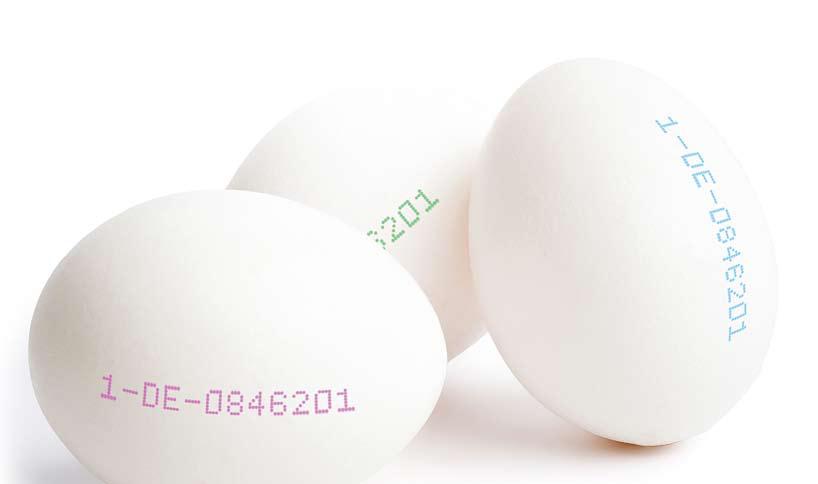試す 金 - 無料
10 things egg producers need to know about egg printing
FoodPacific Manufacturing Journal
|September 2025
How new printing technologies add value where it counts
-

THE AVERAGE human eats around 200 eggs a year. Every year therefore, 1.6 trillion eggs are produced, weighing over 90 million tonnes. And if they are to be sold commercially, all of them (or the boxes they are sold in) need to bear an information code.
Egg printing is an important function - and here are ten key facts that producers should know about the egg printing machines they use.
1. Egg printing is mandatory in most countries
Government regulations in many countries mandate that eggs carry specific information, such as expiry dates, production dates, traceability data and supplier specific information, to ensure transparency and food safety. By marking eggs with unique identifiers, producers can trace products back to their source, facilitating swift responses to any quality or safety issue.
2. Regulations are not the same everywhere
Many countries take their lead from the US, where egg marking is regulated by the Food & Drug Administration (FDA), also working with the WTO to harmonize food standards around the world. US eggs (and the cartons they are sold in) typically carry information that identifies the producer and a three-digit code that represents the date when they were packed (001 = 1 January). In the EU, eggs are stamped with a mark indicating the farming method, country of origin, and a unique producer identifier.
Other countries follow similar patterns, but changing regulations can be hard to follow and producers should always check with local authorities. In Brazil, for example, regulatory changes in November 2024 led many producers to believe, falsely, that every individual egg had to be coded.*
3. Egg codes are there for consumers too
このストーリーは、FoodPacific Manufacturing Journal の September 2025 版からのものです。
Magzter GOLD を購読すると、厳選された何千ものプレミアム記事や、10,000 以上の雑誌や新聞にアクセスできます。
すでに購読者ですか? サインイン
FoodPacific Manufacturing Journal からのその他のストーリー

FoodPacific Manufacturing Journal
Vietnam's durian farmers power up with XAG drones
AS VIETNAM experiences the \"durian gold rush,\" farmers are turning to smart agri-tech, notably XAG agricultural drones, to stay ahead. In the Mekong Delta, where durian exports have soared to $3.3 billion, growers use drones to cut costs, improve yields, and work more safely, adapting quickly to the demands of this booming fruit market.
2 mins
September 2025
FoodPacific Manufacturing Journal
Matcha's popularity is fueling innovation beyond beverages
The trend reflects consumer preference for natural ingredients that promote mental and physical well- being, according to GlobalData
2 mins
September 2025

FoodPacific Manufacturing Journal
Packaging fresh pasta?
Sustainable flowpacks are the preferred packaging format, says SÜDPACK
2 mins
September 2025

FoodPacific Manufacturing Journal
A crisis of trust in the food aisle
WHY does reading a food label feel like you need a translation tool to fully understand it?
3 mins
September 2025
FoodPacific Manufacturing Journal
The 5Ms challenge to leaders towards excellence at home and at work
FILIPINOS are recognized for their creativity and leadership but often struggle to sustain their efforts.
7 mins
September 2025
FoodPacific Manufacturing Journal
Strategic opportunities in the nutraceuticals market
AHEAD of Vitafoods Asia, Informa Markets held a panel discussion on July 29, 2025 to define priorities for scaling credible, research-backed nutraceutical products across the Asia-Pacific region.
3 mins
September 2025
FoodPacific Manufacturing Journal
Unfolding the canvas of innovation: A glimpse into the "Flavorscape of the Future"
IN THE fast-paced food and beverage industry, every new technology and process innovation has the potential to reshape market dynamics.
4 mins
September 2025

FoodPacific Manufacturing Journal
Human milk probiotics A natural innovation shaping maternal and infant health
IN THE nutrition space, few windows are as critical as the first 1,000 days of life. From conception to age two, 80% of a child's brain develops, shaping sensory systems, memory, and learning capacity. The gut and immune system mature rapidly, transitioning from a protected womb environment to one exposed to external challenges. It's a period where nutrition can influence lifelong health outcomes, including susceptibility to chronic diseases, cognitive performance, and emotional resilience.
3 mins
September 2025
FoodPacific Manufacturing Journal
How much damage are ultraprocessed foods really doing to your health?
Most ultraprocessed foods (UPFs), particularly those commonly seen in U.S. dietary patterns, are high in saturated fat, added sugars and sodium (salt), the combination of which is often abbreviated as HFSS, and contribute to excess calories.
5 mins
September 2025

FoodPacific Manufacturing Journal
Thailand's future food industry still young but steadily growing
The early-stage sector is gaining traction through innovation, sustainability, and investor interest in alternative proteins and functional ingredients
5 mins
September 2025
Listen
Translate
Change font size
